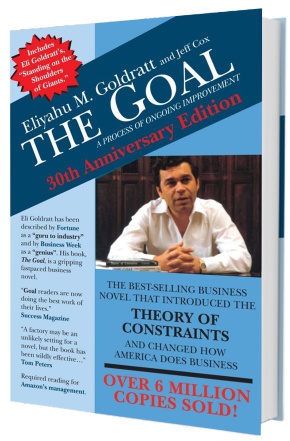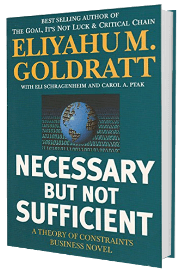Resources
Resources to help you solve persistent operations and supply chain problems for more productivity, revenue and profitability.

Essential reading
The Goal
What it is
One the world’s most-influential business books. In it, renowned author Eli Goldratt explains why traditional efficiency improvement methods fail, and offers a breakthrough alternative.
Why we recommend it
Everything we do is based on the Theory of Constraints methods outlined here. There’s no better way to learn what it is, and how we use it to drive-up performance.
Let us give you a free copy
Essential reading
Necessary But Not Sufficient
What it is
“To realize value, bottom-line value, technology is Necessary but Not Sufficient.” NBNS outlines why most ERP investments, while often necessary, are not sufficient to deliver sustainable business results. System-wide based business management methodology and associated behaviour changes need to be driven outside of a technology platform to solve supply chain and operations management problems.
Why we recommend it
In its analysis of supply chain technology, NBNS ultimately outlines the basis for Demand Driven Replenishment and Production Management approaches and prescribes how to leverage your ERP investment to increase availability, reduce inventory and maximize system throughput.
Let us give you a free copyFEATURED POSTS
4 reasons ERPs fail to achieve business goals
ERP investments are soaring, but most still fail to deliver the desired benefits. We explain 4 reasons why your ERP is missing the mark.
New inventory management approach improves bottom-line results
It’s easy for manufacturers to get stuck making incremental improvements. Here’s how Stalmax made the leap to impressive results in just 10 months.
TOC Innovation Summit 2025
See our presentation: Using Roadrunner Rx Inventory Management Service (client case study) + Goal Simulation Workshop reviews.
ALL POSTS
4 reasons ERPs fail to achieve business goals
ERP investments are soaring, but most still fail to deliver the desired benefits. We explain 4 reasons why your ERP is missing the mark.
New inventory management approach improves bottom-line results
It’s easy for manufacturers to get stuck making incremental improvements. Here’s how Stalmax made the leap to impressive results in just 10 months.
TOC Innovation Summit 2025
See our presentation: Using Roadrunner Rx Inventory Management Service (client case study) + Goal Simulation Workshop reviews.
Stop the chaos: How inventory buffers lower costs, increase profit
How can manufacturers become more efficient and profitable in these chaotic, uncertain times? Start by taming the biggest source of chaos: external variability.
25 years of manufacturing performance innovation with TOC
2025 marks our 25th anniversary! Read about our journey, and how we’ve helped 200+ manufacturers up their game using Theory of Constraints methods since 2000.
6 questions to evaluate a tech investment
Consider these 6 questions from Theory of Constraints to evaluate your next tech purchase.

